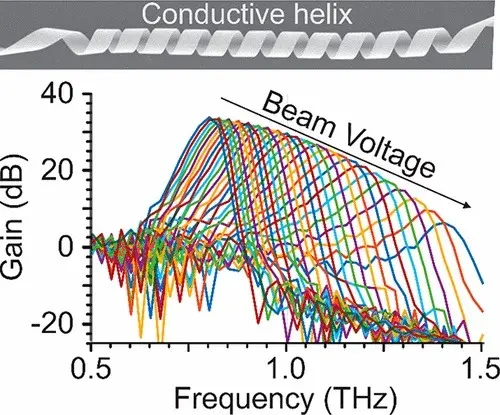Engineers at UW-Madison have developed a new, extremely small self-winding helix that may be easily mass produced and allow manufacturers to develop devices that can access unused sections of the electromagnetic spectrum.
The work is led by Daniel van der Weide, a professor of electrical and computer engineering, and Max Lagally, a professor emeritus of materials science and engineering, as well as former PhD students and postdoctoral research associates Matthew Dwyer and Marcos Martinez.
One of the most valuable commodities in the modern world is the electromagnetic spectrum—the bands of radio and microwave frequencies that cell phones, radio stations, satellites and other devices use to communicate and transmit data.

Soon, however, that spectrum will fill up—but the good news is that there is a large region of unused spectrum in the millimeter-wave range. It’s harder to access due to technical limitations; atmospheric interference makes it difficult to use these wavelengths on Earth, but they are ideal for satellite-to-satellite communication in space and could allow for new types of high-speed, satellite-based networks.
The amplifiers and other devices needed to access the millimeter wave spectrum must be extremely tiny—so small that producing them at an industrial scale is a technical challenge. “In order to exploit these different regions of the spectrum, you have to have amplifiers and receivers that work in a certain frequency,” explains van der Weide. “The millimeter wave spectrum, let’s say above 30 gigahertz, is less crowded. But there’s a reason it’s less crowded. And that’s because it’s much harder to exploit.”
That was on van der Weide’s mind several years ago when he was having coffee with his friend Lagally, an expert in thin films and microscopy. “I was telling him the world desperately needs these small structures,” says van der Weide. “And wouldn’t it be cool if we could strain-engineer a thin film that would roll itself up into a helix, which is a well-known slow wave structure.”
Lagally thought it might be possible, so the pair consulted with Francesca Cavallo, then a postdoctoral researcher in Lagally’s lab (now at the University of New Mexico), who has expertise in strain engineering.
She agreed, and, with funding from the Air Force, the team set about developing a method for synthesizing the helixes. They coated a silicon wafer with germanium, divided the film into tiny strips using photolithography, added layers of chromium and gold to the strips, then chemically separated those strips from the silicon substrate. When they release the strips, strain between the types of metals causes the strips to roll into tiny helixes that are many times smaller than the width of a human hair. “We are winding the helix with a precision that is not achievable by any other means,” says van der Weide. “So that’s why this has people excited. There’s really no way to build a machine to do this.”
The team published the results in the journal ACS Nano in 2021 and also patented the process.
The tiny helix is a core component in a device called a traveling wave tube amplifier. While much of electronics has migrated onto silicon chips, certain high-power, high-gain, high-frequency applications like microwave ovens and satellite-to-satellite communications still rely on vacuum tube technology. In a traveling wave tube amplifier, a radio frequency feeds into the helix, which slows the signal to below the speed of light. That allows it to interact with a beam of electrons shot down the center of or next to the helix, amplifying the signal along its length and thus enabling terahertz communications. (Working with ECE professor John Booske several years ago, van der Weide also proposed silicon-based slow-wave structures for such tubes; Booske is a world expert in such tubes).
The team’s elegant process for fabricating the helix shows there is a path forward for creating these millimeter-scale devices. Yet, there are still significant challenges to overcome. Like all electronics at that tiny scale, the helixes have difficulty dissipating heat, which can cause the material to break down (though the team is currently working on unique solutions to that problem). “We also need a special antenna to couple energy into and out of these things,” says van der Weide. “So there’s a lot of development that still needs to take place. But if you don’t have a slow-wave structure like the helix, none of that really matters. That’s the exciting aspect of this strain engineering.”
Featured photo caption: Professor Daniel van der Weide, research associate Marcos Martinez and their colleagues developed a tiny helix that could open up a new type of satellite-to-satellite communication.